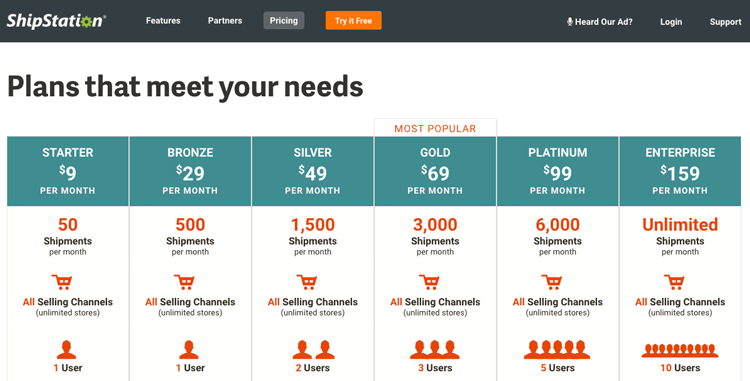Tooltester is supported by readers like yourself. We may earn an affiliate commission when you purchase through our links, which enables us to offer our research for free.
Have a look at the Google Trends graph below. See the little blue and red lines? Yep, they represent the public’s interest in Shopify and WooCommerce, two solutions for creating a fully-fledged online store. As you can see, interest in Shopify has been steadily growing in recent years, while interest in WooCommerce has remained pretty level.
While Shopify may seemingly be more popular, the usage statistics paint a different story. According to BuiltWith, WooCommerce’s share of the top 1 million eCommerce sites is 29%, vs Shopify’s 19% - making it the most widely used store builder in the market.
Which just goes to show - you can’t really decide which is the best one based on numbers alone. Ease of use, flexibility, features, payment options and integrations are much more important factors to consider - and what’s ‘right’ for another store owner may not be right for you.
That’s why we’ve put together a complete guide to help you choose between the two ecommerce solutions!
Let’s dive right into our Shopify vs WooCommerce comparison.

Google Trends comparison of worldwide searches in the last 5 years
So, first and foremost:
Shopify vs WooCommerce – Overview
| Round | Shopify | WooCommerce |
|---|---|---|
| Round 1: Ease of Use | Excellent | Poor |
| Round 2: Themes and Flexibility | Great | Great |
| Round 3: Product presentation and features | Good | Good |
| Round 4: Payment options | Good | Good |
| Round 5: Customer Logins and Checkout options | Great | Great |
| Round 6: Shipping Cost Settings and Carrier integration | Good | Good |
| Round 7: Tax Settings | Great | Great |
| Round 8: Multilingual capabilities | Ok | Great |
| Round 9: Security | Excellent | Ok |
| Round 10: SEO capabilities | Good | Great |
| Round 11: Mobile Apps | Great | Good |
| Round 12: Uptime & Pagespeed | Great | Good |
| Round 13: Support | Great | Ok |
| Round 14: Prices | Good | Good |
| Side-by-Side Comparison | 4.7/5 | 4.4/5 |
| Conclusion | Click to see final result | |
WooCommerce vs Shopify: A Video Comparison
Make yourself comfortable and check out our video review:
> Try Shopify for free
> Sign up for WooCommerce here
What makes Shopify unique?
We’ve written a complete guide to Shopify before, but the long and short of it is that it’s a web-based ecommerce platform, which includes hosting. And the keyword here is “platform”. They have their own app store, where you can buy tons of extra functionality (which you’ll find out more later on).
This philosophy has proved a winning one. Launched in 2006, the Canadian company now claims to look after more than 1 million businesses in 175 countries. This is especially impressive since they don’t offer a free plan.
And WooCommerce?
Another complete solution to create an online store easily. The main differences here are that WooCommerce is a) open-source and free, and b) it’s a plugin for WordPress. So yes, you will need to have a hosted website to use it, and yes, you will need to have WordPress installed on it too (find our full WP tutorial here).
If you already use WordPress and are familiar with plugins, then great, this could be a pretty attractive option already. But if you’re still shopping around (no pun intended) for the best way to create your online store, let’s take a closer look with our detailed Shopify vs WooCommerce comparison. WooCommerce is also really popular for creating online stores; its market share is impressive.
Round 1: Ease Of Use
Hands down one of the easiest solutions available for a complete online store is Shopify. This is because from the moment you create an account, they will guide you through the complete setup.
They take care of the hosting for you, and will even give you the option to “play around” with your store before publishing it. It goes without saying that you won’t need any technical abilities to get started in minutes.

Adding a product in Shopify
WooCommerce is also pretty easy to set up. The only thing to consider is that there are a few steps needed beforehand. These include installing, or updating, WordPress on your website, and then installing the plugin. We’re not going to lie, it can be a little overwhelming if you’ve never done it before.
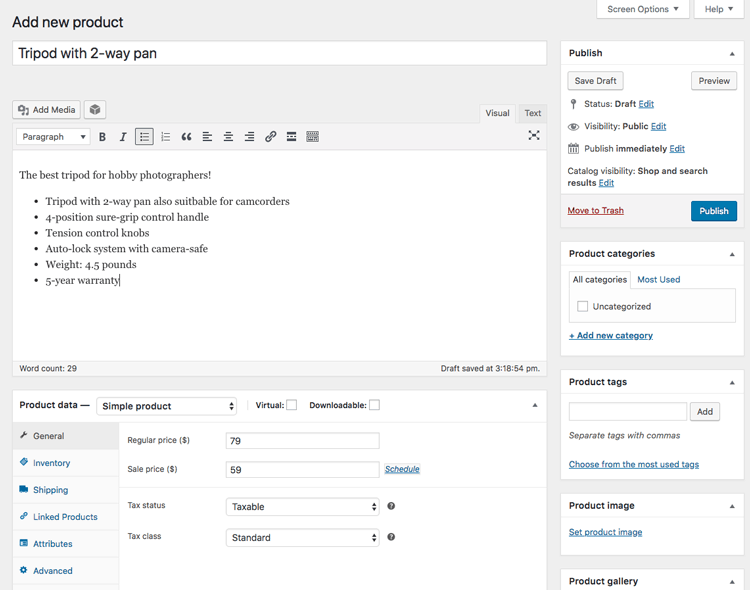
Adding a product to WooCommerce
But the good news here is that certain hosting providers such as Bluehost offer a 1-click installation that automatically installs WordPress and WooCommerce for you. Maybe not in one click, but two or three at the most, which is still pretty dang good.
Round 2: Themes and flexibility
The themes are essentially your virtual shop window. So you’ll be happy to hear that Shopify has its own theme store, which comes with over 70 different themes. Some are premium (ranging between $150-300), but a lot of them are free. Most of them come with customization options so you can change their look and feel without touching one line of code. All the templates are mobile responsive, so they’ll look good on any device.
Premium themes offer more options, but if you really want to tailor the style to your liking, you’ll have to get your hands dirty with the Liquid programming language or hire someone to do it for you. A great thing is that you are not limited to the templates Shopify provides themselves as Themeforest has more than 1,200 Shopify themes available.

WooCommerce doesn’t have its own theme store, but you can use third-party services to source them. On Themeforest, for instance, there is a whopping 1,300+ WooCommerce themes available, with prices ranging from $14 to $139. There are also free themes, but these don’t come with any support.
Winner: both have their pros and cons, let’s call it a draw.
Round 3: Product presentation
Pretty even here. Both Shopify and WooCommerce offer options to create product descriptions, upload pictures, let users zoom in on the images, and you can easily add variation such as product color or size. You can also add product videos easily.

Shopify product display on their standard theme (with active zoom)
Want to add extra display options, such as augmented reality demos, 360° images, or product reviews? Both Shopify and WooCommerce allow you to enhance your product pages through their vast library of extensions and apps, which can be easily enabled. WooCommerce offers around 100 product page extensions, while Shopify’s App Store has around 200 apps in the ‘product options’ category.
One thing to note: because WooCommerce will be essentially operating “within” your WordPress theme, some images or galleries might not play super nice straight away, which can be a bummer.
Winner: well, no one really - they’re both excellent when it comes to giving you product display options. Another draw.
Round 4: Payment options
Probably one of the most complicated/important things to consider for your shop. Shopify offers two kinds of options, but it gets rather confusing, so bear with us here. First, as soon as you set up a Shopify store, you will automatically have PayPal Express Checkout enabled.

Shopify payment settings
Credit card processing is best done through Shopify Payments as you will face extra fees from Shopify if you are using an external payment processor. BUT, the service is only available in the US, UK, Canada, Australia, New Zealand, and a handful of countries in Asia and Europe at this point.
Which means that if your business is located elsewhere, you will have to rely on what they call a “payment gateway”, or a third-party service. These are country-dependent and the fees vary greatly, so it will take a bit of homework to decide what’s best for you.
Likewise, WooCommerce offers different “payment gateway” extensions. Adding PayPal and support for credit cards via Stripe is free. Other options such as Authorize.Net, Amazon Payments or Braintree aren’t and will set you back $79 a year minimum. There are also numerous other payment options, most of which come at a price.

WooCommerce payment settings
In conclusion, both services offer a good range of payment options. But there is also a bunch of stuff to consider in terms of where you are located, and how much you want to spend on extra fees to accept all the $$$ that customers can’t wait to throw at you.
Winner: Shopify if you are in one of the few selected countries where Shopify Payments is available. If not, WooCommerce wins this round. No points in this round.
Round 5: Customer Logins and Checkout options
Both services offer customers the option to log in to process their payments or to continue to check out as slick incognito ninja guests.
Shopify’s customer logins can be made mandatory or optional, and lets customers see their order history and status, as well as being able to save delivery and payment information. One cool thing is that orders made before a customer creates a login can be associated with their account once they register, provided the same email address is used.
WooCommerce offers its basic ‘My Account’ feature out of the box, but it can be enhanced with additional paid plugins (for example, if you want to be able to customize the design of the Account page that customers see). It’s also possible to enable social logins via plugins - although these will set you back between $49 - $79/year.
Furthermore, both Shopify and WooCommerce make it easy to send automatic emails to customers who didn’t complete their purchase (“Abandoned cart recovery”). It’s included in all of Shopify’s plans by default. For WooCommerce you’ll have to use one of the many available plugins of which some are free.
Shopify offers a “one page checkout”, which lets you skip the cart and go directly to the payments page, but you will need to implement it with a few lines of code.
“One page checkout” is also available with certain WooCommerce themes.
Round 6: Shipping Cost Settings and Carrier integration
Both Shopify and WooCommerce let you add a shipping price based on different parameters i.e.: local, international, next-day delivery etc… so far, so standard.
But if you want to get a bit more technical, you can also enable real-time shipping cost estimates at checkout, which offer a super precise price based on the day your carrier will pick up the parcel (USPS, FedEx, UPS and many more). However, one word of warning: WooCommerce requires paid plugins to display real-time rates. You can also combine it with Shipstation, which conveniently lets you print shipping labels.
Shipstation Extension for WooCommerce
With Shopify, you can enable third party-calculated shipping rates for free if you have an Advanced Shopify plan or higher. If you’re on Basic Shopify, you can get it added for an extra $20/month. But here’s something they don’t really tell you: you can actually get it for free if you switch from a monthly to a yearly subscription. You just need to speak to the support team to activate this.
Dropshipping businesses should probably look to Shopify since the platform offers native support for partnerships with Amazon, Rakuten and Shipwire amongst others. They also have a great app, DSers, for AliExpress integration. And they provide comprehensive guides about how to make the most from your stockless shop.
WooCommerce doesn’t have a native dropshipping option, but there is the AliDropship plugin, which we’ve reviewed here.
Winner: you probably guessed it - it’s a draw. This one really depends a lot on your specific setup.
Round 7: Tax Settings
No big difference here: both options let you display prices with, or without, taxes. Shopify will calculate US (and Canadian) taxes automatically for you. Automated registration-based taxes are also available for store owners in the US, Canada, EU, UK, Norway, Switzerland, Australia, or New Zealand. If you want to offer VAT exemptions for your EU customers, you’ll need a paid plugin (Exemptify).
With WooCommerce you can automate your worldwide taxes, which is nice but, of course, requires a paid plugin (e.g. TaxJar). It’s free though if you only have a single tax nexus. Pretty neat.
Winner: no one, a draw. Shopify still has a tight lead.
Round 8: Multilingual capabilities
Shopify users have been scratching their heads for years over how to offer true multilingual support for their stores. For a long time, one expensive option was to duplicate the store or to add subdomains. Then there was the option to add a third-party app like Langify, although at $17.50 a month, that wasn’t exactly cheap, either.
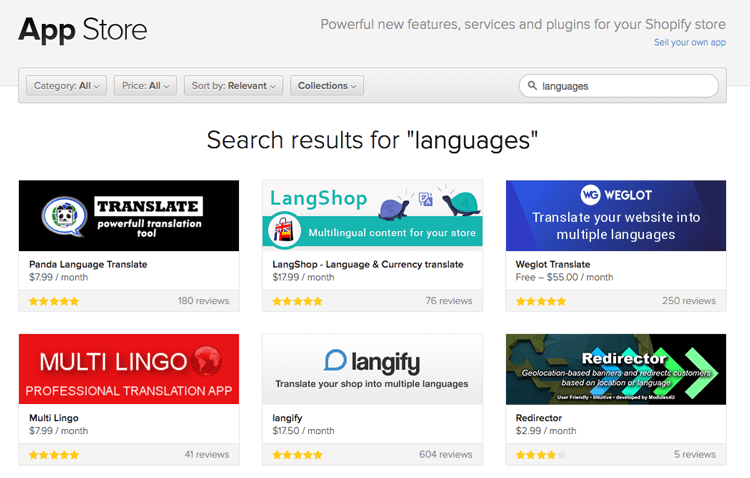
Language apps in the Shopify App Store
Thankfully, Shopify has now made it much easier with its native support for adding languages. This allows you to choose from a list of around 130 languages, and add up to 5 to your site (unless you’re on Shopify Plus - if so, you’ll be able to add 20!).
Additional languages will get added as a folder to your URL (e.g. yourstorename.com/fr), and users will be able to select between languages (provided your theme allows this).
The only kicker? You’ll still need to purchase a translation app to be able to show translated content:

WooCommerce is the clear winner here thanks to the reliable and well-established WPML plugin. It enables a complete multilingual solution and costs $79 the first year, and $59 thereafter. Still not cheap as chips, but it sure beats Shopify (until they make translations a native part of the platform too, at least).
Winner: yes, this time we have a clear winner! It’s WooCommerce.
Round 9: Security
Shopify is a hosted service, which means that they take care of any security issues in the background. They have the power to make any security holes disappear as soon as they learn about them.
Interestingly, they even encourage people to hack into their platform! But it’s not as bad as it sounds: through Hackerone, Shopify awards bounties to anyone who can find possible exploits, subsequently making the platform safer. Oh yeah, Shopify is also PCI compliant right out of the gate. That’s important if you are planning to accept credit card payments.
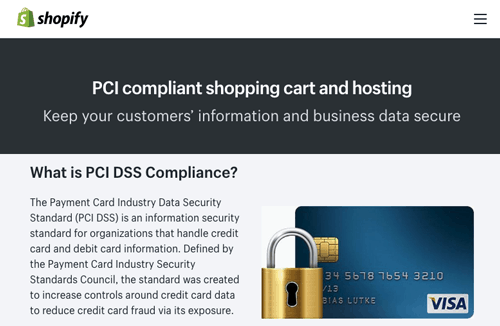
But that’s not all: you can also secure your account using two-step-authentification. And of course, a free SSL certificate from Shopify with all their plans. The only thing where Shopify is quite as good: backups. To download a copy of your entire store, you’ll have to use a plugin like Rewind. It’s $3/month for very small stores (up to 20 orders) but costs go up quickly once you hit more than 600 orders/month ($39/month).
With WooCommerce, security is a different story. WordPress is a very popular platform among hackers and therefore has frequent security exploits. Since you have to install WordPress & WooCommerce on your own server it’s you who is responsible for security updates. If you are a solo founder and out on vacation (or sick), no one will close these security holes for you.
You can reduce the risk a little bit by using a managed WordPress hosting like Siteground, Dreamhost or WPEngine, but in terms of security, it still won’t be even close to Shopify’s standards. WooCommerce is not PCI compliant by default either as this depends on various factors such as your chosen hosting. You can follow these guidelines to reach PCI-DSS compliance though.
You’ll also need to set up SSL yourself with your hosting provider (which is very easy and usually free these days using Let’s Encrypt).
Winner: Shopify scores as it’s a much more secure platform overall.
Round 10: SEO capabilities
Wanna crush the competition with your Google ranking? Shopify’s got you covered. You can edit all the SEO settings, from meta title to 301 redirects. There are two downsides, though.
Rich snippets: these are metadata that search engines like Google use to understand the content of your page better. It’ll then be able to display things like the manufacturer, the item’s availability and a user rating alongside the search results page. To include these in Shopify you’ll either have to get an app (here’s one for ratings and another one for product data) or dive into your store’s code.
Page URLs: Shopify doesn’t give you complete freedom choosing your URLs. For the blog it’s using a subfolder structure such as /blog/news/, which isn’t ideal. Also for regular content pages it’s using a /pages/ subfolder in the URL. (Thanks to Jordan for pointing that out.)
For WooCommerce, once again you’ll need a bit of digital elbow grease. Or you can just add a simple SEO plugin, and there are great free options with advanced features such as our fave Yoast SEO. To add rich snippets there are plenty of WP plugins available, some of them even for free.
All in all, from an SEO perspective, WooCommerce is certainly more powerful than its competitor (if you know what you are doing!).
Winner: WooCommerce enables you to squeeze out more SEO juice in competitive markets. You probably noticed it: WooCommerce equalized. It’s 6:6 now!
Note: if you’re looking for an ecommerce builder with better SEO features than Shopify, then BigCommerce is a good choice (read our BigCommerce review, our guide to BigCommerce SEO and our Shopify vs BigCommerce comparison).
> Is Shopify good for your SEO?
Round 11: Mobile Apps
Shopify provides a user-friendly and powerful app to manage and monitor your store completely.
You’ll be able to see your sales directly in the dashboard (live, per day, per week etc), and the customers that spent the most at your store (for these clients, it could be interesting to offer a discount code to encourage them make their next purchase).
The “Orders” section enables you to see all your orders (fulfilled, unfulfilled or partially fulfilled) and abandoned checkouts (when a customer add items to his/her cart but does not complete payment).
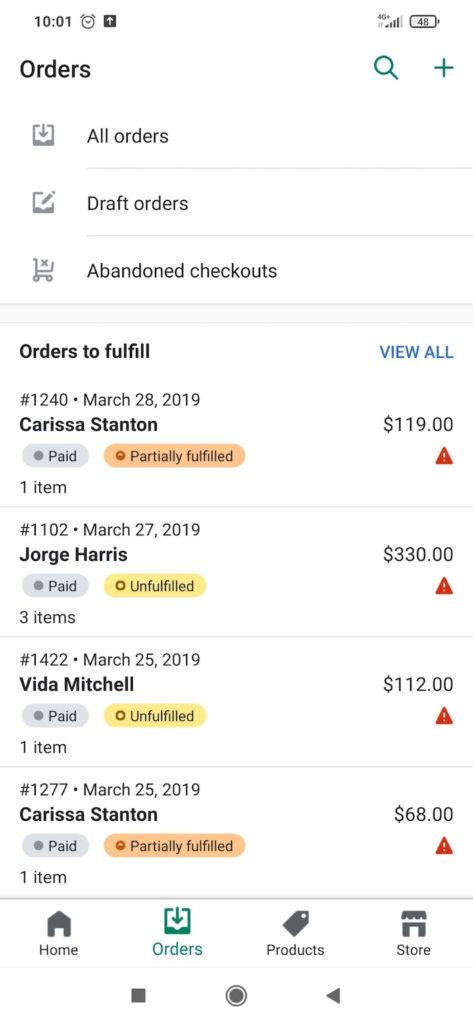
In Shopify’s Products section, you will find product lists, inventory, collections, gift cards, and can edit product details.

Shopify’s Reports section is also useful - all the analytics you need are there. But you can also create custom reports, e.g. sales over time, payments with method, sessions over time, and so on. There’s even a Live View world map to see where your orders come from.
Compared to Shopify, the installation for the WooCommerce app is a lot more complicated. Before being able to use it, you have to install the Jetpack plugin (see “Plugins” section in your WordPress instance). Then you will have to login to the app with your WordPress.com account.
On the WooCommerce app homepage, you will see 3 stats: visitors, orders and revenues (for the present day, last week, last month etc). There is also an “Orders” and “Products” section, where you can add and edit products, and also search for products using various filters.

Winner: Although the WooCommerce app offers similar features to Shopify, it doesn’t provide the custom reports, filtering options, live view feature and marketing features that Shopify does. With WooCommerce, you will only be able to manage your store. Shopify is more powerful: it also enables you to build new pages, blog posts and navigation menus. So no surprises that this round goes to Shopify.
Round 12: Uptime & Pagespeed
Not to be ignored, because Google punishes bad uptimes and slow sites. And it’s hard to compare fairly here because while we have clear (and very good) results for Shopify, WooCommerce will depend entirely on how fast and reliabe your web hosting service is.
So if you have a hosted WordPress site, it’s up to you to ensure that you can reach an uptime of 99.95% or higher (some hosting companies will even give you a level agreement with guaranteed uptime).

Shopify’s Uptime on our test site
Winner: since Shopify has scored truly impressive uptime records and great server speed in our tests, they win this round.
Round 13: Support
Another extra point for Shopify here: all their plans come with dedicated personal support via phone, email and live chat so you can bother their poor staff 24/7 if you so wish.
WooCommerce relies on its large community of benevolent geeks because it doesn’t have any official support unless you purchase a WooTheme. There are, luckily, plenty of forums with guides and technical step-by-steps out there.
Round 14: Prices
Last but not least. The question everyone’s been waiting for: how much does it cost?
Well, it kinda depends. At first, WooCommerce looks like the cheapest option thanks to its 0$ price tag. But once you start adding extra features, web hosting ($5-15 per month), domain name (around $10 per year), premium themes ($59 one-time), plug-ins and custom coding it can quickly become a money pit as our analysis explains in more detail. You could even easily end up spending more than with the Shopify plans which are respectively:
- $29 / month for Basic Shopify
- $79 / month for Shopify (the standard one)
- $299 / month for Advanced Shopify
It’s worth noting that you get a tiny discount if you plan on paying for more than a year at once, so check out their full list for a better overview.
Winner: Shopify is easier to calculate, WooCommerce is a bit more flexible as you can choose your own hosting. As it depends so much on your preference we wouldn’t be able to pick a clear winner here. Another draw.
Shopify vs WooCommerce: Side-by-side Comparison
|
Large & Medium Stores
|
Large & Medium Stores
|
|
|---|---|---|
| Ease of use | ||
| Choice and flexibility of templates | ||
| SEO | ||
| Product presentation | ||
| Product variants | ||
| Cart function | ||
| User ratings | ||
| Article numbers | ||
| Payment options | ||
| Sale of digital goods | ||
| SSL encryption | ||
| Customer log-in area | ||
| Coupon codes | ||
| Shipping cost settings | ||
| Dropshipping | ||
| Tax settings | ||
| Article management | ||
| Confirmation emails customizable | ||
| Importing product data | ||
| Exporting product data | ||
| E-Commerce analysis | ||
| Exporting order data | ||
| Support |
FAQ Chat Telephone |
FAQ Chat Telephone |
|
|
Basic Shopify $29 Shopify $79 Advanced Shopify $299 |
Starter $13.99 Plus $17.99 Pro $31.99 |
|
Overall rating |
||
Shopify vs WooCommerce Conclusion: What should I pick?
In the end, Shopify manages to beat WooCommerce 5:2 (7 draws). What an exciting finale!
But as the result is so close you can imagine that there are plenty of scenarios when actually WooCommerce would be the better choice. Let’s get straight to the point.
You should choose WooCommerce if:
- You already use WordPress and you’re completely in love with it and its plugins
- You absolutely need multilingual support
- You want to squeeze the last bit of SEO juice out of your store
- You don’t care about speed or scaling and just need the cheapest option available…
From our point of view a good way to start is the Bluehost WooCommerce plan. It will save you the pain of having to install everything yourself.
But if none of the bullet points above describe your online business plan, then you definitely go with Shopify. When you think about it, it’s just so much easier to set up. It’s not that expensive. It’s fast. Far simpler to manage. And it also comes with tons of features and support.
So like with any venture, just make sure you have a very clear plan for the kind of ecommerce you want to build. It should then be very easy to make the right decision and run your highly-lucrative online business empire.
Good luck!
We keep our content up to date
14 Sept 2021: Mobile Apps (Round 11)
02 Jul 2021: Multilingual feature updates.
21 Apr 2021: General updates.
16 Sep 2019: Shopify vs WooCommerce video added.
10 Apr 2019: Shopify video updated.
13 Feb 2019: Cart abandonment options added.
25 Oct 2018: Side by side comparison added.
THE BEHIND THE SCENES OF THIS BLOG
This article has been written and researched following a precise methodology.
Our methodology


